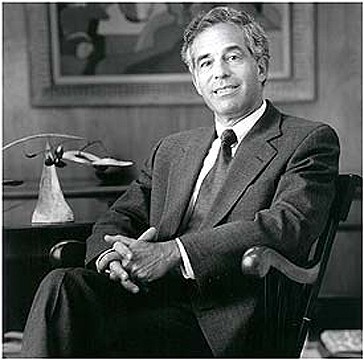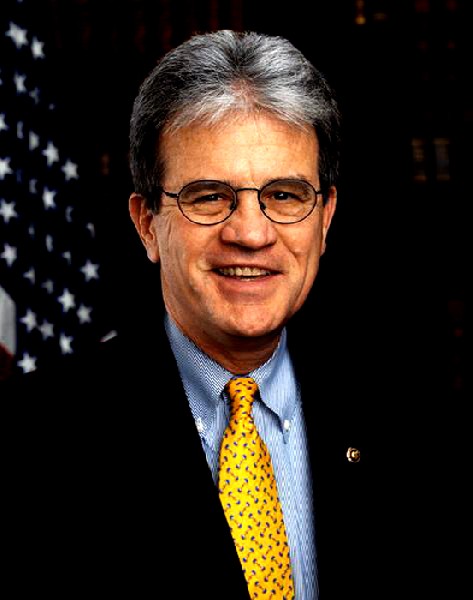Jehuda Reinharz Spins the Rose
To Quote President Obama, I Screwed Up
By: Charles Giuliano - Feb 08, 2009
"In a meeting with alumni leaders in the fall, Jehuda Reinharz, president of Brandeis, stated that he would not allow a student to drop out because his or her parents could no longer afford tuition. I thought that was a wonderful position, it made me prouder of my university than any work by Jasper Johns or Andy Warhol ever didÂ…" Robert Hort wrote in a letter to the New York Times.
Bekah Richards, who as an undergraduate worked for three years at the Rose Art Museum wrote to the Times "Â…Should we fire half of our professors? Close half our buildings? Is there anything we can do that will not compromise our mission and reputation? I hope Brandeis can find another way to survive this crisis. I love the art, and I love the museum. But I would rather have Brandeis without the Rose than no Brandeis at all."
It has gotten ugly. Behind closed doors Reinharz and the Board of Trustees, in a desperate response to a fiscal crisis conflating a 23% decline of the endowment and unsuccessful appeals to a circle of key individuals and foundations devastated by the Bernard Madoff scam, voted to close the Rose Art Museum and sell its collection of 7,000 plus objects estimated to be worth as much as $350 million.
That decision reached without consulting the museum, its staff and overseers, donors, students, faculty or alumni has proven to be a marketing and public relations catastrophe. The loss of prestige and stigma, fueled by universal media condemnation, seemed, in a flash of outrage, to demote the university, founded in the aftermath of World War Two and the Holocaust, as a monument of Jewish learning and culture, to the reduced status of a second class institution.
In exchange for the short term benefit of an infusion of potential revenue to avoid deep cuts of staff, faculty, programming and student loans, Reinharz and the Trustees were willing to plunder the unique treasures of its renowned Rose Art Museum. It was a move without precedent by a major university. For Reinharz, and his supporters among students, alumni and faculty it was an act of triage intended to save the university. Many agree with the mantra that it is better to have Brandeis without the Rose than the Rose without Brandeis.
The emotional debate runs so deep that there can be no winner or clear moral high ground. In a Solomon decision we are asked to choose between the integrity and survival of a great university or hold on to its aesthetic collateral, a collection of works of contemporary art of enormous equity. In such debates, which have occurred through the centuries, art and culture generally draw the short straw in matters of survival. Those who defend the arts under such circumstances are accused of lacking reason and compassion by preferring, in this case, to defend the integrity of objects rather than saving a university with its mandate for education and research. Yet again art is held for ransom in a situation that it did nothing to create. Arguably, in this case, the dire straits of the university stem from the poor decisions of Reinharz and the Board. By contrast, the fiscal policy of the Rose has proven to be sound. It draws no direct funding, other than utilities, from the university and even pays 15% of all money it spends as a fee to the university. The position of the director is endowed by the Foster family. It seems that Michael Rush did a better job of running the museum than Reinharz did of managing the affairs of the university. Logic dictates that the wrong person is getting sacked.
In making such a rash decision, without consulting its base, Reinharz and the Board have suffered a furious backlash. That it may hurt him personally is one issue but the fact that it has caused a negative impact to the reputation, prestige and morality of the university is far more significant. So much so that Reinharz hired Rasky Baerlein Strategic Communications, a public relations firm specializing in crisis management, to craft a carefully worded apology. The full text appears below. In a fit of overstatement Reinharz absurdly compared himself to Obama. "To quote President Obama, 'I screwed up,'" Reinharz wrote. Good grief.
In accepting the apology of Reinharz, Rush, the director of the Rose Art Museum, whose contract will be terminated in June responded that "This does not change the future of the Rose Art Museum as far as I can see. I think the university is to be praised for apologizing for the lack of openness in the process but the apology is for the process, not the content."
The Rose is to be transformed as a fine arts center for students and faculty. It will include studio, exhibition and office space. It remains unclear what happens to the collection and how it will be conserved. There is an implication that it will be available for study and research but will phase out of being a museum open to the general public. By ceasing to be an accredited museum Reinharz and the Board will be free to sell its assets. Sanctions by professional organizations may not be taken against an institution which no longer exists. One assumes the most valuable objects will be liquidated over the next several years. There is apparently enough reserve for the university to pay its bills for the next two years. By then there may be some recovery in the depressed art market representing a more advantageous time to sell major works.
Given the current state of the economy, and a recovery that is expected to get worse before it improves, we anticipate more bad news such as the Brandeis/ Rose controversy. Arguably, it launched the first round of debates about the integrity of the arts and the treasures of institutions as collateral during a period of recession/ depression. Under such financial pressures the arts are always vulnerable. One cannot have guns and butter.
The fate and status of the arts has surfaced in the debate about the proposed stimulus package before Congress. Initially, the arts were included as a part of the overall economy. It is estimated that 6 million Americans are employed in the arts. Further, it has long been argued that the arts stimulate the economy. Theatres, museums, and the performing arts are destinations for patrons and tourism. Corporations locate in cities and regions that offer a strong range of sports and arts institutions. In the Berkshires, for example, Tanglewood, Jacob's Pillow, museums, and the major theatre companies are a vital part of the economy of the region.
In the debate over the economic recovery bill an amendment by Senator Tom Coburn, Republican- Oklahoma, (S. Amdt. No. 309), states, "None of the amounts appropriated or otherwise made available by this Act may be used for any casino or other gambling establishment, aquariums, zoo, golf course, swimming pool, stadium, community park, museum, theater, art center and highway beautification project."
Babbit could not have stated it more clearly. In this statement Foxwoods and Vegas are glibly equated with The Metropolitan Opera or the Museum of Modern Art. For conservatives like Senator Coburn the arts are just pork like that bridge to nowhere in Alaska. While Congress jumped to bail out Wall Street, its banks, and CEOs, with zero accountability, it will not spend a penny for the arts. My bleeding heart also feels for the croupiers of struggling casinos who are trying to feed their families. What happens when Vegas and Atlantic City go belly up? Not that I would favor putting a dime in the pocket of Steve Wynn or Donald Trump.
Ironically, it was only during the Great Depression of the 1930s that the Federal Government viewed artists as workers. There were the Federal Arts Projects of the Works Progress Administration (WPA) with far reaching programs for the fine and performing arts. Under the New Deal, through the Farm Security Administration (FSA), photographers were dispatched to document the ravages of the Dust Bowl and the plight of the American farmer. Their negatives are a part of the national heritage of the Smithsonian Museums and the Library of Congress.
The WPA and other arts relief programs were attacked by conservatives in Congress, and eventually shut down, for allegedly hiring aliens and communists. Artists were further attacked during the Post War era of McCarthyism and the anti-communist House Un-American Activities Committee (HUAC) investigations.
In that sense the arts are dangerous. Artists express themselves. They tend to embody the concept of Free Speech. This latest move to eliminate the arts from a recovery package recalls the debates when the National Endowments for the Arts and Humanities funded the exhibition of the late Robert Mapplethorpe, the "Piss Christ" photography of Andres Serrano and the yams up her ass performance art of Karen Finley. The controversy ended funding to individual artists by the NEA. During those debates it was pointed out that the combined funding of the NEA and NEH was less than the annual budget for military marching bands.
The uproar over National Endowment for the Arts funding of controversial artists began in 1989, when the Rev. Donald Wildmon of the conservative American Family Association of Tupelo, Missouri, held a press conference to denounce NEA funding of "anti-Christian bigotry," referring to the exhibition of Serrano's photograph, "Piss Christ" of a crucifix submerged in the artist's urine. The controversy included Mapplethorpe, Annie Sprinkle, and Finley. Shortly after the American Family Association's press conference, Senators Jesse Helms (R-NC) and Alfonse D'Amato (R-NY) denounced Serrano's work; thirty-six senators signed a "letter to the NEA expressing outrage." Rep. Dick Armey, a Republican from Texas and long-time opponent of federal arts support, circulated a letter signed by 107 representatives to the NEA denouncing a retrospective by Mapplethorpe: He described the work as "morally reprehensible trash."
During a time of national crisis and hard times yet again the arts, and its alleged excesses, are the target for conservatives, fundamentalists, the religious right, and ersatz patriots. They pride themselves in never setting foot in an art museum, theatre, or heaven forbid, attending an opera or ballet. But this is precisely where, in times of trouble, we find our humanity, heart and soul. Where some find spiritual solace in church others seek it in museums or theatres.
Desperate times call for drastic measures. Brandeis University is not the first or last institution to view its treasures as liquid assets. The debates will continue as more institutions face financial crisis. Some will argue that hard times call for a reevaluation of cultural assets. How to make selective cuts and deaccessions to save institutions even if they violate established legal, ethical and moral guidelines? It is indeed a conundrum with no simple answers. But the Brandeis/ Rose precedent has made it perfectly clear that such decisions must include input from the communities they impact and should be viewed as a last resort when all other options are exhausted. Such decisions should be made with full knowledge of ethical and legal consequences, as well as, the collateral damage to prestige and moral reputation that will resonate for generations.
Text of Jehudah Reinharz letter:
Dear Members of the Brandeis community:
The past ten days have been extremely difficult for all of us. I have heard from many of you and listened carefully to your criticisms and constructive suggestions. I have read every message on the faculty list serve, and the thoughtful letter sent to me by a group of faculty last night. I have also heard from students, staff, alumni, university presidents and complete strangers about my statements regarding the vote by the Board of Trustees concerning the Rose Art Museum.
In retrospect, I wish I had handled the initial statements I made in a far more direct way. Unfortunately, those statements did not accurately reflect the Board's decision authorizing the administration to conduct "an orderly sale or other disposition of works from the university's collection." The statements gave the misleading impression that we were selling the entire collection immediately, which is not true. The University may have the option, subject to applicable legal requirements and procedures, to sell some artworks if necessary, but I assure you that other options will also be considered. The Museum will remain open, but in accordance with the Board's vote, it will be more fully integrated into the University's central educational mission. We will meet with all affected University constituencies to explore together how this can best be done.
I regret as well that I did not find a more inclusive and open way to engage the Brandeis community in the deliberations that led to the Board's decision.
I take full responsibility for causing pain and embarrassment in both of these matters. To quote President Obama, "I screwed up."
Having learned from this experience, I will do my best, as will the entire administration, to work together with all of you in a collaborative manner. We must cooperate as we move forward to confront our financial crisis. But we also have to take bold steps. Obviously, we have many tasks ahead of us regarding the curriculum and the budget.
In meetings with members of the faculty and with students in the past few days, I have been heartened by the enormous reservoir of good will, imagination and willingness to work hard to guarantee that Brandeis will continue to thrive as a first-rate institution of higher learning.
Sincerely,
Jehuda Reinharz
LA Times Christopher Knight Re Arts Bill




